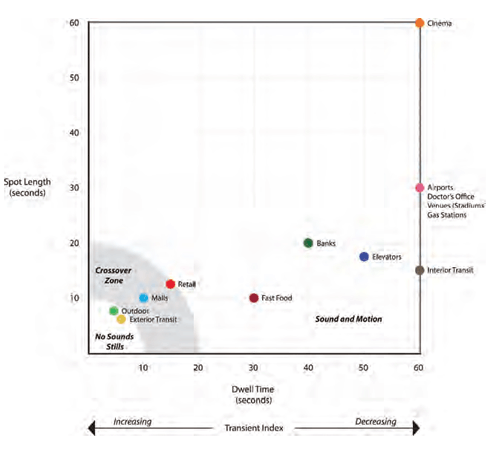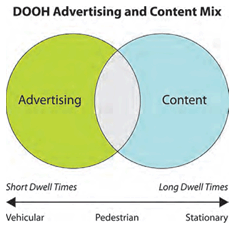The Revenue Road Map for Digital Out of Home Networks
The digital signage industry, with its wide range of deployments, diverse venues, and multiple formats, continues to enjoy unprecedented growth. Retail outlets and malls, airports, banks, gas stations, elevators, sports stadiums, bars, restaurants, and schools represent just a few of the venues and applications where Digital-Out-Of-Home (DOOH) networks have been deployed.
Despite the significant revenues that the DOOH industry has achieved to date, the strategic planning behind many of these networks has taken a secondary role to deployment issues. There appear to be far too many “if you build it they will come” views towards revenue generation with DOOH signage. Many companies are making mistakes by overlooking the key elements of success, thereby hindering their ability to optimize revenue and profitability.
What we need is a guide for developing a successful DOOH network. In effect, a “road map” that companies can use to help guide them through the steps required to evaluate, strategize, and deploy the optimum mix of components to maximize revenues.
THE CRITICAL SUCCESS FACTORS FOR REVENUE DEVELOPMENT
Five key success factors have been identified, all of which are essential components in assessing a DOOH opportunity and achieving its maximum revenue potential:
- 1. Define the objectives and key variables.
- 2. Determine the role of the venue.
- 3. Assess the role of content and how to configure the network effectively to maximize revenues.
- 4. Review, define, and refine the sources of revenue.
- 5. Develop ways to successfully market and sell the advertising component of each DOOH signage network.
1. Objectives and Key Communication Issues
Completing a business plan is a vital first step. One of the most important components of the plan is determining what you want to accomplish. Three critical areas of focus have been identified to provide guidance:
A. The Network: What is the primary mandate of the DOOH network? Do you want to inform, train, entertain, help sell merchandise, and/or make money? Most digital networks are a combination of multiple objectives.
B. The Audience: Research, especially acceptable audience metrics, are fundamental to the success of an advertising-dependent DOOH network. The more dependent the model is on revenues, the more important the role of research.
C. The Market: It’s difficult to accurately estimate the long-term revenue potential of a DOOH network without adequate market knowledge. Here are some guidelines:

This illustrates how the key DOOH network elements — sound, viewing time, and use of stills/animation — interrelate with the venue’s dwell time (viewing opportunity) to arrive at the optimum and most effective mix.
Look elsewhere. Many DOOH networks have been deployed in similar venues in other regions or countries. Take the time to analyze what others have done and determine if their success can be replicated and mistakes avoided.
Solicit potential advertisers. Find out as much as you can about their marketing, advertising investments and objectives and try to determine what it will take to have funds committed to your DOOH network.
Is there other signage in place and is it revenue generating? Be wary of the potential impact on revenues of multiple deployments. Introducing a new (and competitive) media format doesn’t necessarily mean that revenues will increase exponentially. Why? Because advertisers have become accustomed to the inherent value of each media they buy. If the advertiser wasn’t interested in purchasing the media format and venue before, introducing a DOOH network won’t necessarily alter that thinking.
2. The Role of the Venue
Use these guidelines to help compile the best “component parts” for your DOOH network. Environment: Every venue has a slightly different environment. Understanding how consumers interact within it will help bring the viewer and the content/advertising opportunity together.
What is the viewing opportunity and dwell time for consumers? In an airport you have considerable dwell time with passengers waiting in departure hold rooms. An airport DOOH network can run more content with longer commercials using broadcast creative. However, running a 30-second spot in a mall with a 10-15-second viewing opportunity fragments the message and lessens its impact.
Noisy or quiet? For busy, noisy environments (i.e., transit station), care should be taken in determining whether the network should include a sound component. Not all DOOH networks require sound to be effective.
Is it a captive viewing opportunity? Captive venues (like those in airports or cinemas) have a more attentive audience. The combination of large numbers and a captive, attentive audience is more desirable to advertisers.
Location, location, location: Like real estate, the correct mix of where and how digital signage is located is critical. Digital signage needs to “fit into” the environment, yet be visible and deliver impact. The better you can align the viewing opportunity with signage locations, the more effective the network. Some examples:
Dwell Environments. In airports, signage needs to be located in hold room areas where passengers can watch and listen with minimal interruptions. Screens need to be large enough so exposure to multiple viewers is possible, but not overwhelming to other passengers (who may not be interested in viewing).
Transient Environments. A shorter viewing opportunity, less dwell time, and a busy atmosphere usually necessitate larger, more impactful signage. Choosing the highest traffic locations will maximize overall effectiveness. Ads need to be shorter to be more visually impactful. Sound is a secondary consideration.
Transactional Environments. Most retail DOOH networks are transactional. There is sufficient dwell time, but not always in the same location. Signage has a shorter window to interact with consumers as they move about the store. Shorter spots with higher frequency will be more effective than longer spots with less frequency.

The Landlord: Networks where the landlord is also the owner/operator usually have fewer deployment and operational challenges. However, for many DOOH networks, the operator isn’t necessarily the owner of the real estate. When dealing with a third party there needs to be agreement over a number of critical issues. Some examples:
Active or Passive Landlord: Most landlords will be active during the initial setup stage where structure issues, communication objectives, etc. are agreed upon. Additionally, most landlords will want time on the network to communicate with their customers. This may impact revenues and operational costs as saleable space is utilized.
Access to Data: For retail DOOH networks, having access to product movement data is critical for demonstrating the effectiveness of the advertising and driving sales.
Venue Competition: Multiple advertising formats represent a dilution of the sales opportunity, sets up potentially destructive metrics on price, and creates confusion with advertisers.
Restrictions: Are there any content, category, or legislative restrictions? Any constraints could severely impact revenue projections.
The Financial Model: Landlords tend to over value their real estate. Guaranteed revenue streams and/or a percent of sales are common requests. DOOH networks have significant up front capital and highoperation costs that preclude higher financial payments. Don’t make the mistake of letting ROI objectives dictate what the revenues should be — this is a recipe for disaster. Work from the top down, not the bottom up to arrive at realistic and achievable revenues. When projecting revenues, establishing three thresholds is always recommended.
Low Revenues: A worst case scenario.
Mid Revenues: Expected revenue levels based on the business plan.
High Revenues: A possible outcome where expectations are exceeded.
If the revenue projections in the model don’t hit the targeted financial thresholds, review the costs to see what can be eliminated. (Your network integrator can help with this analysis.) Remember, the vast majority of DOOH network failures were due to unrealistic revenue projections.
3. The Content and Configuration Dilemma
The viewing opportunity is often overlooked when content is discussed. A good rule for assessing the importance of content: As viewing time increases, so does the importance of content.
Content needs to be relevant and engaging for the target audience and align to the exposure opportunity. For example, DOOH billboards can combine advertising and content — i.e., a TV broadcaster can provide changing headline news throughout the day, so the content is the advertising.
For pedestrian-based media (such as retail or transit), the advertising and content should be separate and need to align to the exposure opportunity. The ad spots are shorter and the content should be as well (5-10-second content bursts, as an example, relevant headline news-type information).
In an airport, content needs to be high quality and timely given the long 45-minute-plus dwell time and, most importantly, appropriate for the predominant audience — business travelers.
One of the challenges facing DOOH networks is a lack of industry standardization (formats) and measurement. Each DOOH operator is encouraged to support the Out of Home Video Advertising Bureau (OVAB). OVAB has established audience guidelines that provide details on how audience studies should be conducted. Long term, it’s essential that the industry adopt common standards in order to be accepted readily by the advertising community.
4. Sources of Revenue
Many DOOH networks look to the advertising industry for revenues. But advertising budgets and media selection are not as fluid as everyone thinks. The inherent advantages that are built into most DOOH networks aren’t fully utilized by advertisers. For example, changing an ad four times per day for a fast food chain (different creative for breakfast, lunch, dinner, and drivethru) only makes sense if the advertiser can accommodate these creative changes — most aren’t in a position to do so currently. It will take time for advertisers, agencies, and outof- home specialists to build this increased flexibility into strategies and, when they do, the communication effectiveness of DOOH networks will improve dramatically.
Network operators also make the mistake of depending too heavily on advertising revenues while ignoring other lucrative sources of funds.
POS/Promotional Budgets: Funds that are traditionally directed to POS displays or price discounts might be more effective if a portion of these funds are directed to a DOOH network. DOOH signage will improve overall consumer awareness, potentially resulting in higher sales.
CO-OP Funds: These funds, based on product purchases, are used to fund flyers and newspaper inserts. Inserts represent a hard, non recoverable cost. Co-op expenditures in DOOH networks come back to the landlord in the form of revenue share (or ownership). Having a co-operative and motivated landlord who can assist in helping push funds to digital can significantly impact the top line. By supplementing this with revenues from traditional ad budgets, the network operator reduces their dependence on a single revenue source.
Types of Advertisers: Many DOOH networks focus on one source of ad revenue, either national or regional/local. Focusing on both will optimize revenues.
National Advertisers: Usually take a wait and see attitude. The DOOH network needs to be introduced at the planning stage and the better the metrics (research) that can be provided, the higher the probability of inclusion.
Local and Regional Advertisers: Tend to be more flexible and faster to react to new opportunities. Regional advertisers will have larger budgets, while local budgets are smaller and more seasonal.
5. Marketing and Selling the Signage Opportunity
Marketing represents an investment in future success. Establishing competitive rates and correctly positioning the network needs to be done early on.
One of the most critical components is research, especially when the primary source of revenue is advertising. Without it, there are no metrics that media personnel can use to establish the relative value, audience coverage, or effectiveness of the network relative to its costs. Here are some guidelines:
Is the audience quantifiable? The larger the numbers of potential viewers, the better the revenue opportunity.
Is the audience qualifiable? The demographics (and lifestyles) of the audience are paramount before many advertisers will purchase new media. Advertisers are looking for information about the audience, including accurate information on demographics — age, sex, income levels, occupations, etc. This allows advertisers to align their communication objectives with those of the DOOH network. High-quality, venuespecific information can be obtained through research specialists such as Scarborough, Peoplecount, MRI, Nielsen, or Arbitron.
Is the audience desirable? As an example, higher income earners are more attractive to luxury goods marketers, as are business-to-business consumers. The more defined the DOOH’s venue and its audience, the higher the probability that it’s desirable to a wider range of products and services (i.e., cinemas or airports )
Is the network impacting the audience? Advertisers want to look beyond the numbers to actual results. Is the DOOH network communicating with its audience and having an impact? Awareness research is useful. Far better, if the DOOH network is integrated with a retail outlet (as many are), there is a wealth of sales information that can be used to correlate advertised products with in-store sales to produce meaningful ROIs.
Another marketing element that is vital to revenue generation is the rate structure. Rates can only be effectively developed with reliable audience data as its cornerstone. A basic understanding of other like or competitive media will help create a viable rate structure for the DOOH network. The changeability of digital introduces an increased opportunity for exposure, so intrinsic research is required to determine the average number of exposures per location for each viewer. From this, a CPM can be determined. The primary target audience and the quality of the venue will also play an important role in determining rates. As a guide, the shorter the viewing opportunity, the shorter the loop length (and the length of the spots), the lower the CPMs. More captive, higher quality audiences like cinemas and airports generally command a higher CPM.
Take care not to build too much complexity into the rates early on. Resist the temptation to promote the maximum flexibility of the network (i.e., selling day parts). Once the network is established and demand builds, this may become a viable option for attracting new advertisers.
Support material needs to reflect the vision of the DOOH network. Print, video, and web material are essential elements in the marketing kit. As the network gains traction, additional information on advertiser successes or testimonials, or category ROI effectiveness studies will help drive advertising support.
Virtually every DOOH network has detailed information on ad message frequency and proof of play. For retail DOOH networks, access to product sales data represents a powerful tool in demonstrating its effectiveness. Additionally, attendance at industry trade events and advertising in trade publications increases awareness and helps connect with potential customers.
The final element in the mix is one of the most important — sales. No matter how good the network is, the quality of the sales effort will play a critical role in the network’s long-term success. Setting up a dedicated sales force is an expensive and long-term investment. Other options include rep agreements with digital sales specialists or aggregators. A number of these aggregators are developing multi-venue and multi-platform digital networks. Their advantage is they are single source: they simplify the buying process and have no ownership stake, their role is predominantly sales.
CONCLUSION
We have assessed how the success of a DOOH network results from the interaction of a wide array of critical factors. Unfortunately, there are no easy shortcuts to success. It’s a combination of careful and thorough planning, common sense, and understanding and applying the five key success factors in this article. If you do your homework, you will create the best “component mix” and be in a strong position to maximize revenues and profits and ensure the long-term viability of your DOOH network.
Alan High (alanhigh@clearchannel.com) is president of Clear Channel Malls. His experience with digital signage covers a wide range of formats and venues in out of home. He helped pioneer Clear Channel’s digital products in Dundas Square, Toronto’s equivalent of Times Square, and was instrumental in the launch of Toronto International Airports DOOH network, a joint venture with CBC. He also provided guidance in the launch of New York City’s Digital Urban Panel program, one of the “first” network digital deployments in out of home.










